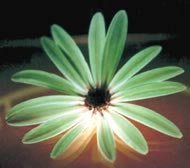A rosy glow

The beauty of genetic engineering: a fluorescent flower. <br>Mercuri A. et al.
Genetic engineering gives us the fluorescent daisy.
It’s produced in Italy and guaranteed to make the face of that special someone light up. It’s the luminous bouquet. Under ultraviolet light the apparently normal blooms glow an unearthly green.
“The fluorescent flowers show that genetic engineering can be developed just for beauty,” says their developer, Tito Schiva of the Experimental Institute of Floriculture, San Remo. The technique should work for any white flower, Schiva adds1.
“It’s a nice thing,” says flower geneticist Erik Souer of the Free University of Amsterdam. “People in a nightclub might like them.” The need for ultraviolet light to enjoy the full effect will limit applications, he says: “It wouldn’t be bought by a housewife at a market.”
But you won’t be seeing a glow in your florist’s window anytime soon. Schiva’s team has no plans to commercialize the invention. It costs about US$1 million to get a genetically modified organism approved in Italy, and the public is hostile to genetic engineering.
“The regulatory climate in Europe remains a problem for commercialization of genetically engineered flowers,” explains John Mason, of the company Florigene, based in Collingwood, Australia. Florigene modifies the colours of carnations, roses and daisies.
The technology will most likely be used to monitor genetically modified crops, says Schiva. His team originally planned to make legitimate hemp crops distinguishable from narcotics – anyone with an ultraviolet torch could detect a fluorescent flower.
Flower power
The bilious blooms owe their glow to green fluorescent protein (GFP). This protein, originally from jellyfish, is one of molecular biologists’ favourite tools. Hitching the GFP gene to a gene of interest and adding both to an organism gives any protein molecules made from the gene a luminous GFP flag.
Scientists use GFP to track molecules as they are shunted around cells, or cancer cells as they migrate around the body. This month, US researchers unveiled piglets for use in organ transplant studies, which have fluorescent snouts and trotters.
GFP has illuminated processes in plant cells before, but this is the first time its eerie glow has been put to decorative purposes.
Schiva’s group initially inserted GFP into plants such as tobacco and sea lavender (Limonium). These flowers’ natural pigment masked GFP. So the team turned to two plants with flowers transparent to ultraviolet light: the prairie gentian (Eustoma grandiflorum) and the daisy (Osteospermum ecklonis). Both make GFP in their flowers to great effect.
The fluorescent fun needn’t stop with green. Proteins related to GFP that fluoresce red in natural light were discovered recently. Putting these into petals “would be a little more spectacular”, Souer says.
References
- Mercuri, A., Sacchetti, A., De Benedetti, A., Schiva, T. & Alberti, S. Green fluorescent flowers. Plant Science, 161, 961 – 968, (2001).
Media Contact
All latest news from the category: Life Sciences and Chemistry
Articles and reports from the Life Sciences and chemistry area deal with applied and basic research into modern biology, chemistry and human medicine.
Valuable information can be found on a range of life sciences fields including bacteriology, biochemistry, bionics, bioinformatics, biophysics, biotechnology, genetics, geobotany, human biology, marine biology, microbiology, molecular biology, cellular biology, zoology, bioinorganic chemistry, microchemistry and environmental chemistry.
Newest articles
Faster, more energy-efficient way to manufacture an industrially important chemical
Zirconium combined with silicon nitride enhances the conversion of propane — present in natural gas — needed to create in-demand plastic, polypropylene. Polypropylene is a common type of plastic found…

Energy planning in Ghana as a role model for the world
Improving the resilience of energy systems in the Global South. What criteria should we use to better plan for resilient energy systems? How do socio-economic, technical and climate change related…

Artificial blood vessels could improve heart bypass outcomes
Artificial blood vessels could improve heart bypass outcomes. 3D-printed blood vessels, which closely mimic the properties of human veins, could transform the treatment of cardiovascular diseases. Strong, flexible, gel-like tubes…




















